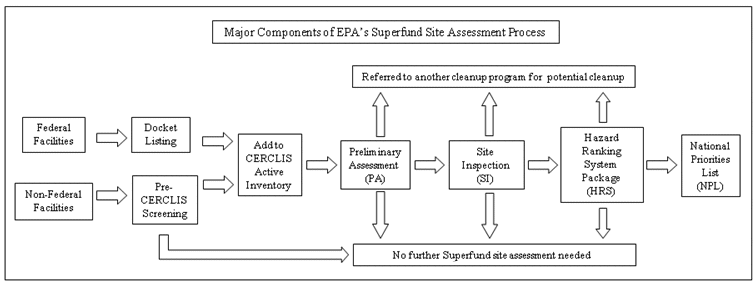Superfund Site Assessment Process
- Superfund Site Assessment Process
- Pre-CERCLIS Screening
- Cleanup Alternatives
- State, Tribal and Other Federal Agency Cleanups
- Site Assessment Training and Guidance
- HRS Quickscore
The Superfund site assessment process evaluates potential or confirmed releases of hazardous substances that may pose a threat to human health or the environment. Hazard Ranking System (HRS) criteria guide the process, which is carried out by EPA, state, tribal or other federal agency environmental programs. After identification of a site, a series of assessments evaluate the potential need for remedial cleanup. This diagram illustrates the major parts of the site assessment process.
Click diagram to expand
About Superfund site assessments
Special Project
Assessment of historic lead smelters.
- EPA Lead Smelter Strategy Summary Report (PDF) (66 pp, 4.2 MB,
About PDF) - Strategy for Addressing 464 Lead Smelter Sites (PDF) (32 pp, 1.1 MB,
About PDF)
Superfund site assessments evaluate site conditions to identify appropriate responses to releases of hazardous substances to the environment. During this process, EPA, states, tribes and other federal government environmental programs collect data to identify, evaluate and rank hazardous waste sites based on HRS criteria. The HRS is a numerically based screening system that uses information from initial limited investigations to assess the relative potential of sites to pose a threat to human health or the environment. It is the principal mechanism EPA uses to place uncontrolled waste sites on the National Priorities List (NPL). Sites with HRS scores of 28.5 or greater are eligible for placement on the NPL. Only sites on the NPL are eligible for Superfund Trust Fund-financed remedial actions. This diagram shows how sites move through the Superfund site assessment process:
Click to expand diagram
The Superfund site assessment process begins with site discovery or notification of a release or potential release into the environment. EPA may be notified of hazardous waste activity by citizens, states, tribes or other environmental programs. At federal facilities, the process starts with a facility’s listing on the Federal Agency Hazardous Waste Compliance Docket (Docket).
Following notification, non-federal sites undergo pre-screening to determine whether the Superfund site assessment process is appropriate. Federal facilities bypass this step; each facility placed on the Docket undergoes a preliminary assessment. Sites identified as appropriate for the site assessment process receive a site discovery date and are added to EPA’s active CERCLIS site inventory. Using HRS criteria, EPA, its state and tribal partners, or the appropriate federal department or agency then conduct a preliminary assessment and, if warranted, a site inspection or other more in-depth assessment. These efforts determine whether a site warrants short-term or long-term cleanup attention. Sites that do not need further attention receive a No Further Remedial Action Planned (NFRAP) designation. Sites requiring further study are referred to appropriate cleanup programs. These programs include EPA’s Emergency Response and Removal program, EPA’s Resource Conservation and Recovery Act (RCRA) Corrective Action program, state and tribal cleanup initiatives such as voluntary cleanup programs (VCPs), the Superfund Alternative Approach (SAA), and the NPL.
At the conclusion of each assessment, the HRS model is applied to derive a preliminary site HRS score. Sites with preliminary HRS scores below 28.5 generally require no further Superfund remedial interest and are assigned a NFRAP decision. The NFRAP decision can also be made at sites with preliminary HRS scores of 28.5 or higher if EPA determines the site would receive a “no action” Record of Decision (ROD) if placed on the NPL. Most sites assessed for potential NPL listing screen out of the program.


